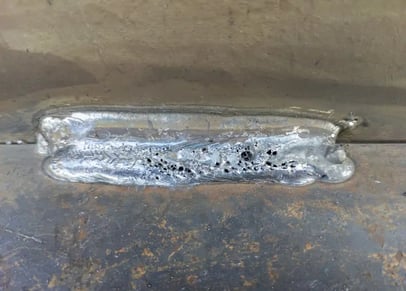What is Porosity in Welding: Finest Practices for Avoiding Porous Welds
What is Porosity in Welding: Finest Practices for Avoiding Porous Welds
Blog Article
The Science Behind Porosity: A Comprehensive Guide for Welders and Fabricators
Comprehending the intricate devices behind porosity in welding is important for welders and makers striving for impressive workmanship. As metalworkers explore the midsts of this sensation, they discover a world governed by numerous aspects that affect the development of these tiny voids within welds. From the structure of the base materials to the intricacies of the welding procedure itself, a multitude of variables conspire to either exacerbate or ease the existence of porosity. In this detailed overview, we will certainly decipher the scientific research behind porosity, exploring its impacts on weld top quality and introduction progressed techniques for its control. Join us on this trip through the microcosm of welding blemishes, where accuracy fulfills understanding in the search of perfect welds.
Recognizing Porosity in Welding
FIRST SENTENCE:
Evaluation of porosity in welding discloses essential understandings right into the honesty and top quality of the weld joint. Porosity, identified by the existence of dental caries or spaces within the weld steel, is a typical concern in welding procedures. These spaces, otherwise correctly attended to, can jeopardize the architectural stability and mechanical properties of the weld, resulting in possible failures in the finished item.

To discover and measure porosity, non-destructive screening approaches such as ultrasonic screening or X-ray examination are commonly used. These methods enable the recognition of interior issues without compromising the integrity of the weld. By evaluating the dimension, form, and distribution of porosity within a weld, welders can make informed choices to enhance their welding procedures and attain sounder weld joints.

Aspects Influencing Porosity Formation
The occurrence of porosity in welding is influenced by a myriad of factors, varying from gas protecting efficiency to the intricacies of welding criterion settings. go now Welding criteria, including voltage, current, travel rate, and electrode kind, also effect porosity development. The welding method employed, such as gas metal arc welding (GMAW) or shielded steel arc welding (SMAW), can affect porosity development due to variants in warmth circulation and gas protection - What is Porosity.
Impacts of Porosity on Weld Quality
The visibility of porosity additionally compromises the weld's resistance to deterioration, as my explanation the entraped air or gases within the gaps can respond with the surrounding setting, leading to destruction over time. Furthermore, porosity can prevent the weld's capability to withstand pressure or effect, more threatening the total high quality and dependability of the welded structure. In critical applications such as aerospace, automobile, or structural buildings, where security and resilience are extremely important, the damaging results of porosity on weld quality can have serious repercussions, stressing the value of lessening porosity with proper welding methods and treatments.
Methods to Minimize Porosity
In addition, using the appropriate welding parameters, such as the proper voltage, present, and travel rate, is vital in preventing porosity. Keeping a regular arc length and angle during welding also helps lower the chance of porosity.

Utilizing the suitable welding method, such as back-stepping or utilizing a weaving motion, can additionally aid disperse warm uniformly and reduce the chances of porosity development. By implementing these strategies, welders can properly decrease porosity and generate top quality bonded joints.

Advanced Solutions for Porosity Control
Executing cutting-edge modern technologies and cutting-edge methods plays an essential role in accomplishing remarkable control over porosity in welding procedures. Furthermore, employing innovative welding techniques such as pulsed MIG welding or modified environment welding can additionally assist minimize porosity concerns.
One more advanced remedy entails using sophisticated welding equipment. As an example, using devices with built-in attributes like waveform control and sophisticated source of power can enhance weld high quality and decrease porosity risks. The execution of automated welding systems with precise control over criteria can significantly reduce porosity defects.
Additionally, including sophisticated monitoring and inspection technologies such as real-time X-ray imaging or automated ultrasonic testing can assist in detecting porosity early in the welding process, permitting for prompt restorative activities. In general, incorporating these innovative solutions can significantly enhance porosity control and boost the overall quality of welded elements.
Verdict
To conclude, understanding the science behind porosity in welding is important for welders and makers to create premium welds. By identifying the factors affecting porosity formation and implementing methods helpful hints to reduce it, welders can improve the total weld quality. Advanced solutions for porosity control can even more boost the welding process and guarantee a strong and dependable weld. It is necessary for welders to constantly educate themselves on porosity and execute finest techniques to accomplish ideal results.
Report this page